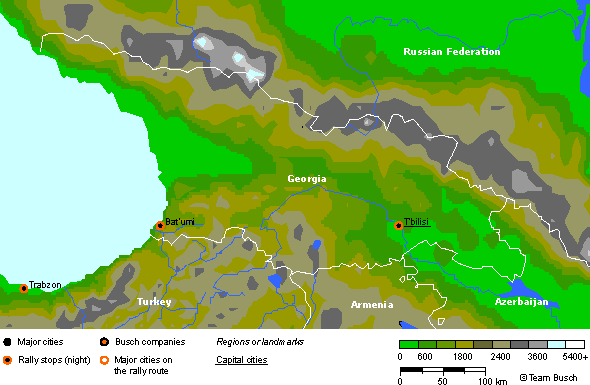|
||||||||||||||||
 |
||||||||||||||||
|
|
Georgia Sak'art'veloArea: 69,700 sq km |
|
Climate: warm and pleasant; Mediterranean-like on Black Sea coastTerrain: largely mountainous with Great Caucasus Mountains in the north and Lesser Caucasus Mountains in the south; Kolkhet'is Dablobi (Kolkhida Lowland) opens to the Black Sea in the west; Mtkvari River Basin in the east; good soils in river valley flood plains, foothills of Kolkhida LowlandElevation extremes: lowest point: Black Sea 0 m highest point: Mt'a Mqinvartsveri (Gora Kazbek) 5,048 m |
Population: 5,066,499 (July 1999 est.)Ethnic groups: Georgian 70.1%, Armenian 8.1%, Russian 6.3%, Azeri 5.7%, Ossetian 3%, Abkhaz 1.8%, other 5%Religions: Christian Orthodox 75% (Georgian Orthodox 65%, Russian Orthodox 10%), Muslim 11%, Armenian Apostolic 8%, unknown 6%Languages: Georgian 71% (official), Russian 9%, Armenian 7%, Azeri 6%, other 7% note: Abkhaz (official in Abkhazia) |
| Médecins Sans Frontières are helping to fight tuberculosis in Georgia. See the link to the MSF-website for more information on MSF's activities in Georgia. |
 |
|
Route notes of the rally: …coming from Turkey. Friday 12th May - Day 12 — Trabzon to Sarphi (border) 150km A two lane coastal road becomes more attractive with some coastal mountains and tea and sunflower plantations. The border was a sleepy backwater but now is being upgraded to become a major commercial gateway. Sarphi to Batumi 25km Mostly through built up residential area with interesting old wooden houses in the traditional style. At first the centre of Batumi appears uninteresting - Soviet Style City but down near the seafront it is a very attractive resort town with parks and very appealing Old Russian colonial architecture. Saturday 13th May - Day 13 — Batumi to Tbilisi 400km Batumi is the capital of the semi-autonomous province of the Ajaarraand so we have to go through a number of 'border' checkpoints to get into Georgia proper. Batumi was the 'Costa' of the Soviet Union and so first we drive throughout residential area behind the coastal strip of disused hotels. Then over some very attractive coastal mountains with tea and lemon plantations to the central plains - The Trans Caucasus. Skirt the city of Katusi which has some historical monuments but not enough to make us stop. Over a forested and attractive lone, low mountain pass and past Stalin's birthplace of Gori. Eventually we join the historic GMH 9 (Georgian Military Highway) which leads over the Caucasus to Russia. The road drops into a scenic river gorge, which Tbilisi is built in. Sunday 14th May - Day 14 — Rest Day in Tbilisi Tbilisi is a mixture of decaying old Soviet and regenerated traditional Georgian. Some old churches to visit and a very attractive old quarter with wooden buildings. Also the modern sector with pavement cafes, boutiques, bars and a good nightlife. Monday 15 th May - Day 15 — Tbilisi to Baku 580km The Route heads to the Azerbaijan border via the town of Sagarejo. Cross the border to Azerbaijan and the day is spent skirting the towns of Seki and Ansu in the foothills of the Caucasus and river valleys with a lot of traditional rural life to be seen and on to Baku and the ferry across the Caspian. Baku is a surprisingly attractive city so we hope we can arrive with a couple of hours to see something of it before boarding the ferry in the evening for the 14-hour crossing. …moving on to Azerbaijan. |